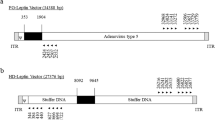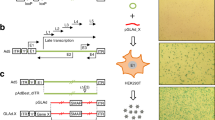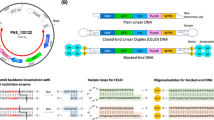Abstract
Recombinant adenovirus is one of most efficient delivery vehicles for gene therapy. However, the initial enthusiasm for the use of recombinant adenovirus for gene therapy has been tempered by strong immune responses that develop to the virus and virus-infected cells. Even though recombinant adeno-viruses are replication-defective, they introduce into the recipient cell, together with the gene of interest, viral genetes that might lead to fortuitous recombination if the recipient is infected by wild-type adenovirus. We propose the use of a dodecahedron made of adenovirus pentons or penton bases as an alternative vector for human gene therapy. The penton is a complex of two oligomeric proteins, a penton base and fiber, involved in the cell attachment, internalization, and liberation of virus into the cytoplasm. The dodecahedron retains many of the advantages of adenovirus for gene transfer such as efficiency of entry, efficient release of DNA from endosomes, and wide range of cell and tissue targets. Because it consists of only one or two adenovirus proteins instead of the 11 contained in an adenovirus virion and it does not contain the viral genome, it is potentially a safer alternative to recombinant adenovirus.
This is a preview of subscription content, access via your institution
Access options
Subscribe to this journal
Receive 12 print issues and online access
$209.00 per year
only $17.42 per issue
Buy this article
- Purchase on Springer Link
- Instant access to full article PDF
Prices may be subject to local taxes which are calculated during checkout
Similar content being viewed by others
References
Norrby, E. 1969. The structural and functional diversity of adenovirus capsid components. J. Gen. Virol. 5: 221–236.
Philipson L., Lonberg-Holm, K., and Pettersson, U. 1968. Virus-receptor interaction in an adenovirus system. J. Virol. 2: 1064–1075.
Devaux, C., Caillet-Boudin, M.-L., Jacrot, B. and Boulanger, P. 1987. Crystallization, enzymatic cleavage, and polarity of the adenovirus type 2 fiber. Virology 161: 121–128.
Louis, N., Fender, P., Barge, A., Kitts, P. and Chroboczek, J. 1994. Cell-binding domain of adenovirus serotype 2 fiber. J. Virol. 68: 4104–4106.
Henry L., Xia, D., Wilke, M., Deisenhofer, J., and Gerard, R.D. 1994. Characterization of the knob domain of the adenovirus type 5 fibre protein expressed in E. Coli.J. Virol. 48: 5239–5246.
Wickham T., Mathias, P., Cheresh, D.A., and Nemerow G.R. 1993. Integrins avb3 and avb5 promote adenovirus internalization but not virus attachment. Cell 73: 309–319.
Bai, M., Harfe, B. and Freimuth, P. 1993. Mutations that alter an Arg-Gly-Asp (RGD) sequence in adenovirus type 2 penton base protein abolish its cell-round-ing activity and delay virus reproduction in flat cells. J. Virol. 67: 5198–5205.
FitzGerald, D.J.P., Padmanabhan, R., Pastan, I. and Wilingham, M.C. 1983. Adenovirus-induced release of epidermal growth factor and Pseudomonas toxin into the cytosol of KB cells during receptor-mediated endocytosis. Cell 32: 607–617.
FitzGerald, D.J.P., Trowbridge, J.S., Pastan, I., and Wilingham, M.C. 1983. Enhancement of toxicity of antitransferrin receptor antibody-Pseuofomonas exo-toxin conjugates by adenovirus. PNAS 80: 4134–4138.
Yoshimura, K., Rosenfeld, M.A., Seth p., and Crystal, R.G. 1993. Adenovirus-mediated augmentation of cell transfection with unmodified plasmid vectors. J. Biol. Chem. 268: 2300–2303.
Seth, P.J. 1994. Adenovirus-dependent release of choline from plasma membrane vesicles at an acidic pH is mediated by the penton base protein. Virol. 68: 1204–1206.
Wohlfart, C. 1988. Neutralization of adenoviruses: kinetics, stoichiometry, and mechanisms. J. Virol. 62: 2321–2328.
Stewart, P.L., Burnett, R.M., Cyrklaff, M. and Fuller, S.D. 1991. Image reconstruction reveals the complex molecular organization of adenovirus. Cell 67: 145–154.
Ruigrok, R.W.H., Barge, A., Albiges-Rizo, C. and Dayan, S. 1990. Structure of adenovirus fibre. II. Morphology of single fibres. J. Mol. Biol. 215: 289–596.
Boudin, M.L. and Boulanger P., 1982. Assembly of adenovirus penton base and fibre. Virology 116: 589–604.
Caillet-Boudin, M.-L. 1989. Complementary peptide sequences in partner proteins of the adenovirus capsid. J. Mol. Biol. 208: 195–198.
Hong, S.S. and Boulanger, P. 1995. Protein ligands of the human adenovirus type 2 outer capsid identified by biopanning of a phage-displayed peptide library on separate domains of wild type and mutant penton capsomers. EMBO J. 14: 4714–4727.
Chaudhary, N. and Courvalin, J.-C. 1993. Stepwise reassembly of the nuclear envelope at the end of mitosis. J. Cell Biol. 122: 295–306.
Schoehn, G., Fender, P., Chroboczek, J. and Hewat, E.A. Adenovirus 3 penton dodecahedron exibits structural changes of the base on fiber binding. EMBO J. In press.
Norrby, E. 1964. The relationship between the soluble antigens and the virion of adenovirus type 3. I. Morphological characteristics. Virology 1: 236–248.
Gelderblom, H., Bauer, H., Frank, H. and Wigand, R. 1967. The structure of group II adenoviruses. J. Gen. Virol. 1: 553–560.
Norrby, E. and Skaaret P. 1968.Comparison between soluble components of adenovirus types 3 and 16 and of intemediate strain 3-16 (the San Carlos agent). Virology 36: 201–211.
Boulanger, P.A. and Puvion, F. 1976. Occurrence of a peculiar type of adenovirus 2 penton oligomer. Intervirol. 7: 126–134.
Karayan, L., Gay, B., Gerfaux, J. and Boulanger R. 1994. Oligomerization of recombinant penton base of adenovirus type 2 and its assembly with fibre in baculovirus-infected cells. Virology 202: 782–796.
Van Oostrum, J. and Burnett, R.M. 1985. Molecular composition of the adenovirus type 2 virion. J. Virol. 56: 439–448.
Chardonnet, Y. and Dales, S. 1970. Early events in the interaction of adenoviruses with HeLa cells. I. Penetration of type 5 and intracellular release of the DNA genome. Virology 40: 462–477.
Lyon, M., Chardonnet, Y., and Dales, S. 1978. Early events in the interaction of adenoviruses with HeLa cells. V. Polypeptide associated with the penetrating inoculum. Virology 87: 81–88.
Greber, U.F., Willetts, M., Webster, P. and Helenius, A. 1993. Stepwise dismantling of adenovirus 2 during entry into cells. Cell 75: 477–486.
Greber, U.F., Webster, P., Weber, J. and Helenius, A. 1996. The role of adenovirus protease in virus entry into cells. EMBO J. 15: 1766–1777.
Horwitz, M.S. 1990. Adenoviridae and their replication, pp. 1679–1721 in Virology Fields, B.N. and Knipe, D.M. (eds.). Raven Press, New York.
Kochanek, S., Clemens, P.R., Mitani, K., Chen, H.-H., Chan, S. and Caskey, C.T. 1996. A new adenoviral vector: replacement of all viral coding sequences with 28 kb of DNA independently expressing both full length dystrophin and (β-galac-tosidase. Proc. Natl. Acad. Sci. USA 93: 5731–5736.
Yang, Y., Li, Q., Ertl, H.C.J., and Wilson, J.M. 1995. Cellular and humoral immune response to viral antigens create barriers to lung-directed gene therapy with recombinanat adenoviruses. J. Virol. 69: 2004–2015.
Petterson, U. and Sambrook, J. 1973. Amount of viral DNA in the genome of cells transformed by adenovirus type 2. J. Mol. Biol. 73: 125–130.
Cuzange, A., Chroboczek, J. and Jacrot, B. 1994. The penton base of human adenovirus type 3 has the RGD motif. Gene 146: 257–259.
Signäs, C., Akusjärvi, G. and Pettersson, U. 1985. Adenovirus 3 fibre polypep-tide gene: implications for the structure of the fibre protein. J. Virol. 53: 672–678.
Kitts, P.A., Ayres, M.D. and Possee, R.D. 1990. Linearisation of baculovirus DNA enhances the recovery of recombinant virus expression vectors. Nucleic Acid Res. 18: 5667–5672.
King, L.A. and Possee, R.D. 1992. The baculovirus expression system: a laboratory guide. Chapman & Hall, London.
Author information
Authors and Affiliations
Rights and permissions
About this article
Cite this article
Fender, P., Ruigrok, R., Gout, E. et al. Adenovirus dodecahedron, a new vector for human gene transfer. Nat Biotechnol 15, 52–56 (1997). https://doi.org/10.1038/nbt0197-52
Received:
Accepted:
Issue Date:
DOI: https://doi.org/10.1038/nbt0197-52
This article is cited by
-
A recombinant virus-like particle vaccine against adenovirus-7 induces a potent humoral response
npj Vaccines (2023)
-
On the use of adenovirus dodecahedron as a carrier for glycoconjugate vaccines
Glycoconjugate Journal (2021)
-
Enteric Species F Human Adenoviruses use Laminin-Binding Integrins as Co-Receptors for Infection of Ht-29 Cells
Scientific Reports (2018)
-
Mapping of Adenovirus of serotype 3 fibre interaction to desmoglein 2 revealed a novel ‘non-classical’ mechanism of viral receptor engagement
Scientific Reports (2018)
-
Adenovirus Dodecahedron, a VLP, Can be Purified by Size Exclusion Chromatography Instead of Time-Consuming Sucrose Density Gradient Centrifugation
Molecular Biotechnology (2015)



